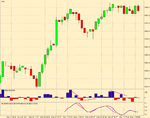Hi all
I was wondering whether anyone here has done any serious study of bid & ask volumes ? I have been using price & volume only for quite a long time, but have often wondered whether the BA volume will reveal anything more useful than can be gleaned from the volume bar alone.
Over the past few years I have read various negative comments on this topic eg.
"Bid & ask volumes are useless because so many transactions are in between the bid & ask spread " (DON'T AGREE)
"BA volumes just add another degree of complexity which overloaded price & volume traders can do without" (MAYBE)
"For every buyer there is a seller and all transactions are created equal so what's the point ?" (DON'T AGREE)
"Times & Sales reveals all anyway" (AGREE, BUT I CAN'T COUNT THAT FAST !)
If anyone has had any actual trading experiences to relate using the BA volume in some way then I would be very interested to hear them. Or anything else around this subject.
In the interim I have constructed a small Excel app to do the work, planning to study EUR :USD futures, and I will report back with some record sheets if anyone shows an interest.
rog1111
I was wondering whether anyone here has done any serious study of bid & ask volumes ? I have been using price & volume only for quite a long time, but have often wondered whether the BA volume will reveal anything more useful than can be gleaned from the volume bar alone.
Over the past few years I have read various negative comments on this topic eg.
"Bid & ask volumes are useless because so many transactions are in between the bid & ask spread " (DON'T AGREE)
"BA volumes just add another degree of complexity which overloaded price & volume traders can do without" (MAYBE)
"For every buyer there is a seller and all transactions are created equal so what's the point ?" (DON'T AGREE)
"Times & Sales reveals all anyway" (AGREE, BUT I CAN'T COUNT THAT FAST !)
If anyone has had any actual trading experiences to relate using the BA volume in some way then I would be very interested to hear them. Or anything else around this subject.
In the interim I have constructed a small Excel app to do the work, planning to study EUR :USD futures, and I will report back with some record sheets if anyone shows an interest.
rog1111

